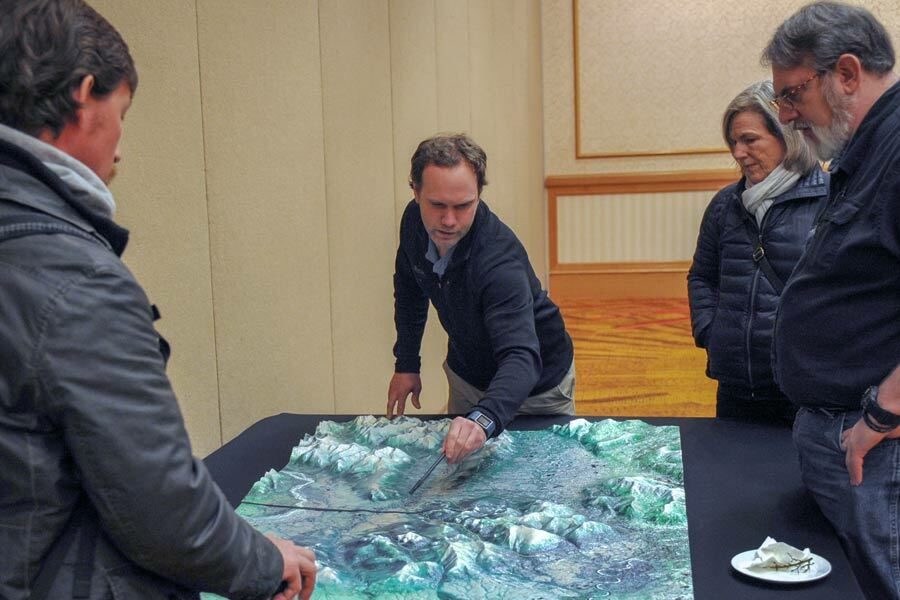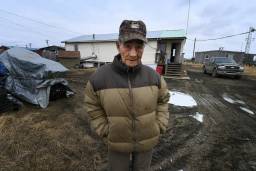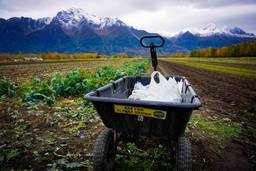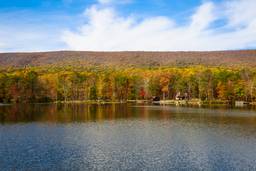The Caribou in the Copper Mine
Mining companies seek to carve up Native lands and wildlife habitat to build a $350 million access road.
Yereth Rosen

ANCHORAGE, ALASKA — In a hotel meeting room in bustling downtown Anchorage, leaders from far-flung Native villages talked about how caribou and roads do not mix.
“The migration pattern’s going to get hindered,” said Tom Gray, representing the Native-operated Reindeer Herders Association at the December 2017 meeting of the Western Arctic Caribou Herd Working Group, an advisory panel made up of locals dependent on and protective of one of Alaska’s two largest caribou herds, 200,000 strong.
The herd roams a vast swath of northwestern Alaska, typically traveling about 2,000 miles a year. Their territory holds wide areas of lichen-carpeted tundra, the northern fringe of the quiet boreal forest, icy and fish-filled streams that flow out of the Brooks Range, sections of the northernmost U.S. national parks — and, if the Alaska Industrail Development and Export Authority (AIDEA) gets its way, a 211-mile road allowing access to a copper-rich northwestern area previously too isolated to justify opening mines.
Supporters say the project will create needed rural jobs and a new source of wealth for the whole state. Opponents see the road as an expensive boondoggle that will carve up habitat, endanger wildlife and disrupt indigenous hunting and fishing.
This debate predates 1980, when the Alaska National Interest Lands Conservation Act set aside 104 million acres as national parklands, wildlife refuges and other protected units. The act also allowed for a section of an Ambler mining road to cut through one of those new parks, Gates of the Arctic, but only recently did a specific road plan finally materialize.
The Bureau of Land Management plans to decide on approval by early 2020.
AIDEA envisions a “private-public partnership” to foot what it estimates will be $350 million for construction (in addition to operating costs), with mining companies chipping in user fees.
Eye-rolling critics characterize the Ambler road proposal as yet another chapter in a history of harebrained Alaska development schemes—“the last of the zombie mega-projects,” wrote John Gaedeke, owner of a lodge on the edge of Gates of the Arctic, in a letter to the Fairbanks Daily News-Miner. The most audacious: Project Chariot, a Cold War-era plan to detonate hydrogen bombs off the coast to create a deepwater seaport. Then there was the proposed railroad tunnel linking Alaska to Russia, a Bering Strait version of the Chunnel (minus the population centers).
Rick Van Nieuwenhuyse, president and chief executive of Trilogy Metals Inc., which is positioning itself to mine Ambler-area copper, pitched the project as environmentally friendly.
The only way to combat global warming, Van Nieuwenhuyse said at the December 2017 working group meeting, is to switch to renewable energy and electric vehicles. “Both of those things require huge amounts of additional copper,” he said, compared to coal power and fuel-driven vehicles. “I like to refer to copper as the green metal of the future.”
He faced a tough audience.
Some members of the working group fret about mine-waste management and potential runoff of dangerous materials. But it is less the mining that worries critics than the two-lane gravel road.
Working group members talked about how caribou movements are altered by the mere presence of roads. They talked about dust, traffic noise and wider ecological impacts of a road, including to water quality and fish. And, when given assurances that the Ambler road would be only temporary — closed to the public to prevent influxes of outsiders and dismantled after mining was over — they invoked past Alaska experiences as a rebuttal.
“Somebody’s pulling somebody’s leg here,” said Vern Cleveland of the Inupiat village of Noorvik, the group’s chairman. “Look at the Dalton Highway.”
That 414-mile highway was built in the 1970s oil-boom era, running parallel to the Trans-Alaska Pipeline. It was also touted as temporary, and for industrial use only. In 1994, it opened to the public.
Charles Saccheus, an Inupiat elder from the village of Elim, talked about being 10 years old and traveling by dog sled across the caribou hunting grounds. “I love caribou. It’s what feeds me,” he said. “It’s our way of life from time immemorial.”
Whatever benefits come from the road, they will not go to the region’s people, he predicted.
“We’ve got to be very careful about our fish and wildlife.”








